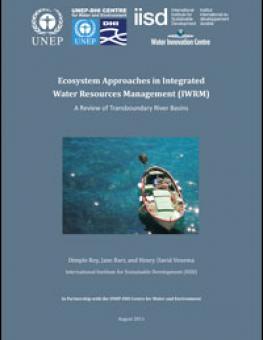
Ecosystem Approaches in Integrated Water Resources Management (IWRM): A Review of Transboundary Basins
Integrated water resources management (IWRM) combines land and water management through broad-based stakeholder participation to realize multiple co-benefits in watersheds.
IWRM recognizes the economic benefits of managing water and related resources in an integrated manner to provide high levels of ecosystem services (ES). In turn, ecosystem management incorporating ES valuation and management is an increasingly popular and useful means of achieving IWRM goals as well as other socio-economic and environmental benefits.
This report provides a review of selected transboundary river basins to ascertain the application of ecosystem-based approaches and to draw specific lessons for effective IWRM in international contexts. Selected basins are those associated with the Mekong, Okavango, Congo, Danube, Jordan, Red and La Plata Rivers and represent Asia-Pacific, Africa, Europe, West Asia, North America and Latin America regions of the world respectively. The analysis focuses on whether basin agencies are recognizing and incorporating bundled ecosystem services into basin management.
Recommendations encourage the use of specific tools such as ecosystem goods and services assessment, valuation and communication and assist in the realization of co-benefits through transboundary basin organizations. Recommendations include the use of ES to develop a benefit sharing approach, or a win-win approach as opposed to more traditional competitive approaches. We also recommend the development of international ES markets to encourage such ecosystem management. Finally, we link this ecosystem management approach in transboundary basins to its immense potential for peace-building and cooperative management between riparian countries.
Participating experts
You might also be interested in
National State of the Environment Report: Uzbekistan
The National State of the Environment Report (NSoER) is a comprehensive document that provides a snapshot of current environmental trends in Uzbekistan's socio-economic development for citizens, experts, and policy-makers in the country of Uzbekistan.
Essential Monitor's Guide for Prairie Water Retention
This guidance document aims to make water retention monitoring a more accessible practice from a technical standpoint by demystifying some of the considerations required to get started.
Freshwater connectivity can transport environmental DNA through the landscape
A new study conducted at IISD-ELA found that the movement of water between freshwater bodies can transport eDNA which complicates the question of how accurately it can be used to monitor species.
What Is the UAE Framework for Global Climate Resilience, and How Can Countries Move It Forward?
With the introduction of the new framework for the Global Goal on Adaptation (GGA), COP 28 marked a milestone for adaptation. We unpack key outputs and set out how countries can move forward by strengthening their national monitoring, evaluation, and learning (MEL) systems.